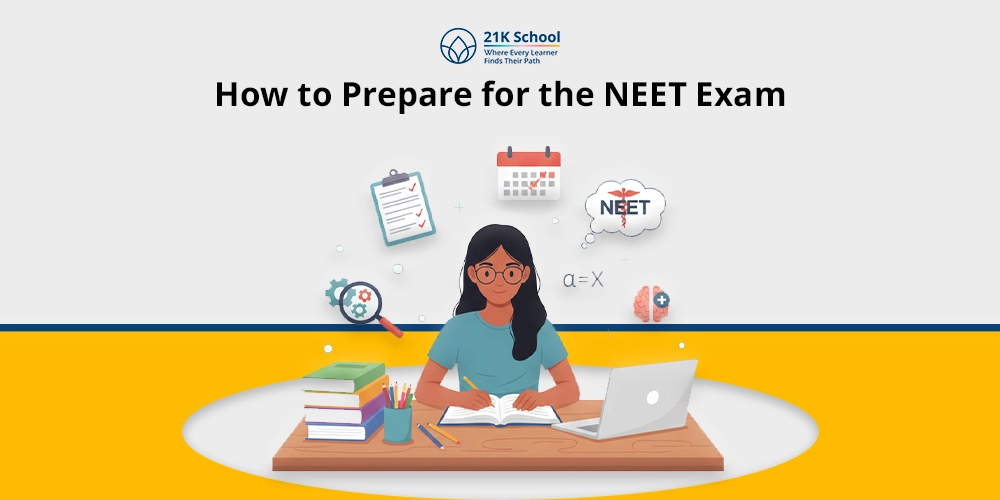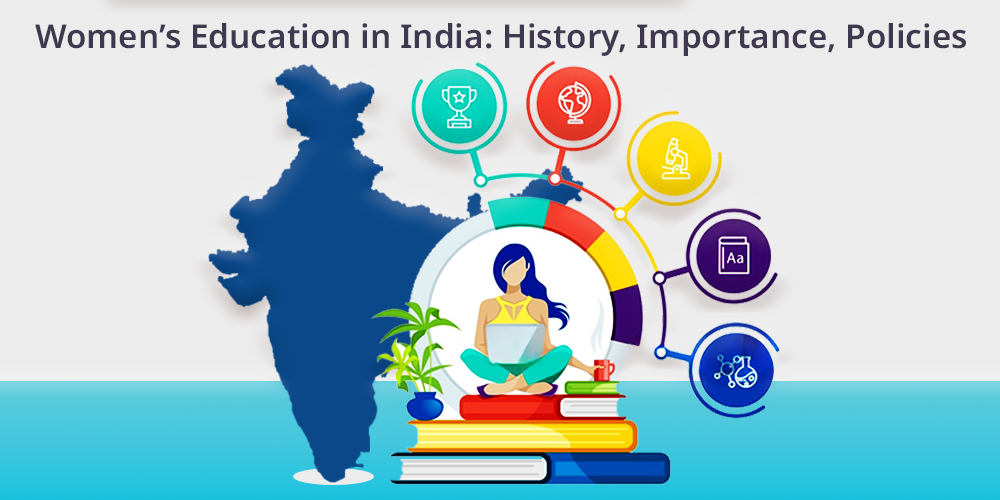
Have you ever wondered why women’s education in India is essential?
Women’s education is an essential part of every society. Women’s education is important because the contribution of women in the economic, social, and financial sectors brings developmental growth to the country.
Women play a vital role in the empowerment of the society and nation. Education is the equal right of every human being whether it is a man or women.
Even in the 21st century, the literacy rate of women in developing countries is still low. Developing countries like India have a women’s literacy rate of 65.46% only.
One of the main reasons for the low literacy rate in women is a lack of proper resources, gender disparity and old societal thoughts which create imbalances in the literacy rate in India.
Education not only provides empowerment to women but also helps in developing their capabilities in order to become financially successful.
In view of such a scenario, the Government has also introduced various women’s education programs such as Beti Bachao Beti Padhao, Girl Child Education, Sukanya Samriddhi Yojna, Uddan and so on.
Contents
- What is Women’s Education?
- Objectives of Women’s Education in India
- Problems of Girl Education in India
- Factors Affecting Women’s Education in India
- Importance of Women’s Education in India
- History of Women’s Education in India
- Women’s Higher Education History in India
- Leaders Who Fought for Women’s Education in India
- Dalit Women’s Education in India
- Statistics of Women’s Education in India
- State wise Women’s Education in India
- Current Policies for Women’s Education in India
- Conclusion
What is Women’s Education?
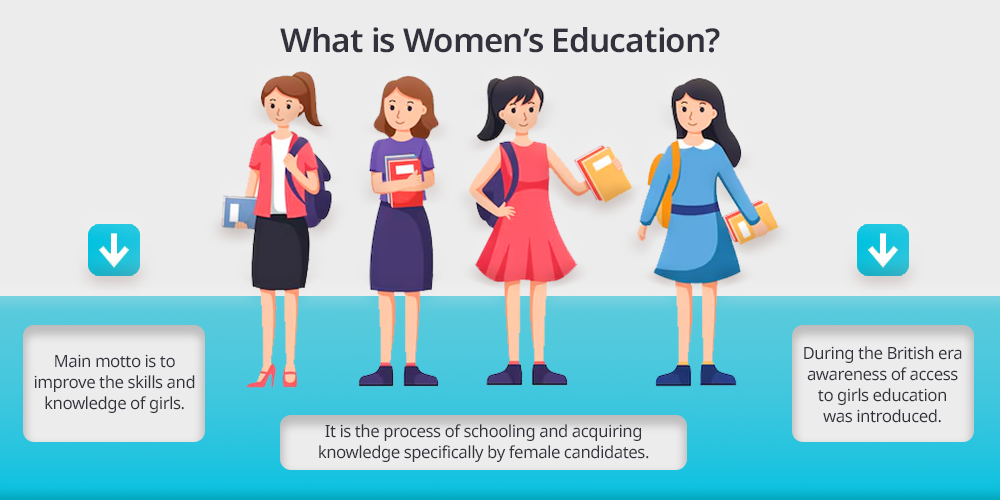
Women’s education can be defined as the process of schooling and acquiring knowledge specifically by female candidates. Women’s education helps in the empowerment of the society and nation.
Women’s education’s main motto is to improve the skills and knowledge of girls. Educating girls and women is very important for positive change. Our Indian Constitution states Education is an equal right for everyone.
During the 19th and 20th centuries, women were meant for household work only and education was not easy access for women at that time. During the British era awareness of access to girls education was introduced.
During that time various reformers such as Ishwar Chandra Vidyasagar, Raja Ram Mohan Roy, KeshavKarve, Savitri, David Hare, Annie Besant and Jyotirao Phule created the importance and need for women’s education in India.
According to the reformers, women’s education will play an important role in alleviating poverty in the country.
Objectives of Women’s Education in India
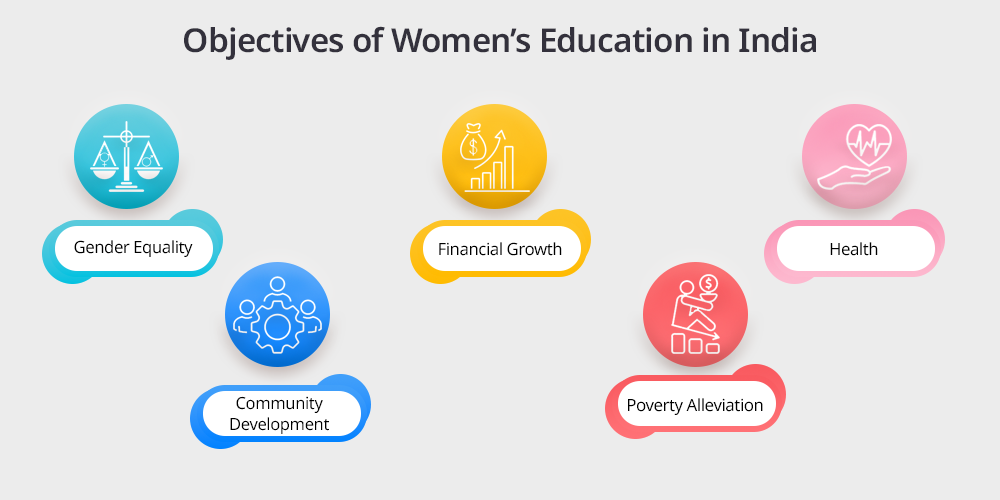
Improving women’s education is essential and brings a positive impact on health and economic trends.
In India, Various government schemes were introduced for girls to promote women’s education and to change the mindset of people on girl child.
Here you can check the objectives of Women’s Education in India:
- Gender Equality: Women’s Education helps in reshaping gender equality. Gender Inequality has created hindrances for women from availing equal opportunities. Women’s education will empower gender equality which will help in breaking the old stereotypes.
- Financial Growth: Women’s Education helps in developing the Indian economy. Educating women allows them to become financially independent and generate income which will help increase the GDP of the Indian economy.
- Health: Educating women will create an impact on women’s health. Educated women have a lower infant mortality rate as compared to illiterate mothers. Education also helps women to have knowledge of female health problems and hygiene.
- Community Development: Women’s Education is essential in developing a positive community. By educating women they can give their insights into the development of the society which is very beneficial for the growth of the nation.
- Poverty Alleviation: Women’s Education will help in reducing poverty. Educated women are more likely to provide income which will help in increasing the GDP of the Indian economy and allows in alleviating the poverty of the country.
Problems of Girl Education in India
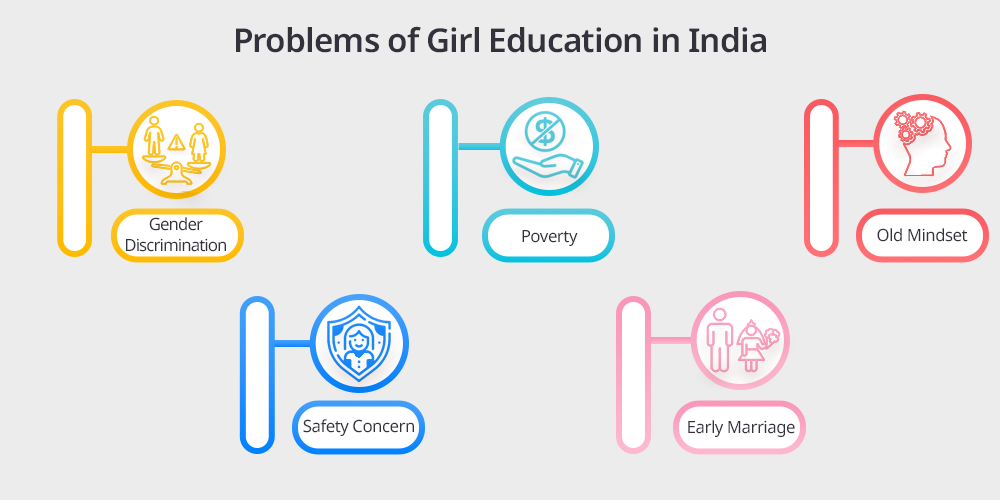
Girls’ education is very essential in developing a proper Indian education system.
Even after implementing so many government initiatives womens education faces lots of challenges such as gender bias, poverty, safety reasons, poor infrastructure, transportation cost, old mindset, etc.
Which creates hindrances to Girls’ education. Here you can check the reasons for the lack of Girls education in India.
- Gender Discrimination: Gender Inequality is one of the major reasons for women’s education. Boys were given more priority in terms of education and other facilities. Gender disparity creates hindrances in education among girl children.
- Poverty: In India, the poverty rate is 4.5% and children especially girls who fall under the poverty line find it tough to complete their education. Even in various rural areas girl child can’t complete even their classes due to the low income of their family.
- Old Mindset: In India, old societal thoughts have created loopholes for women’s education in India. Even in the 21st century, various people think that women are meant for household work only and education will not create any impact.
- Safety Concern: Safety concerns are one of the major reasons for the lack of education for women. In India, the women’s crime rate is around 70% due to this fear many girls drop out from school every year. Safety concerns have created hindrances in female education in India.
- Early Marriage: Early marriage is one of the reasons that has created challenges for girls education in India. Early motherhood and responsibilities disrupt women’s education and make them resistant to education.
In India, the child marriage rate is around 23% which creates hindrances among them to complete their schooling.
The importance of learning is very much essential because it promotes a healthy understanding of education among women.
Factors Affecting Women’s Education in India
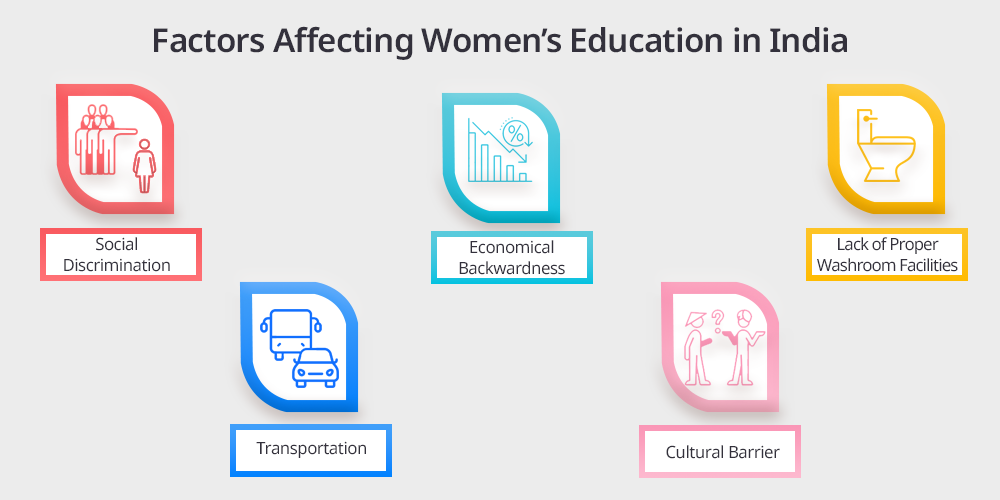
In India, there are various factors such as social discrimination, economic backwardness, cultural norms, etc. that hinder women’s education in India. Due to social stigmas women in India still lack access to education.
The government has introduced various women’s education programs to promote women’s education and enhance the literacy rate in India. Here you can check the factors that affect women’s education in India:
- Social Discrimination: Social discrimination is one of the major reasons for the lack of girl child education in India. Social discrimination has created unfair treatment against gender, social status, race, caste, and so on. Due to this reason, women face backwardness in education.
- Economical Backwardness: Children of various low-income families especially girl children are unable to complete their education due to lack of income, which makes them drop dropout before completing their 5 grade.
- Lack of Proper Washroom Facilities: One of the major reasons that hindered women’s education is the lack of hygiene and sanitation. Various local or rural schools don’t have proper toilets and sanitation which is due to which girls hesitate to go to schools.
- Transportation: In India, many students face a lack of transportation which it very difficult for them to go to school. Travelling from one place to another is very hectic for girl children and fear of safety is also one of the major reasons why women’s education is affected.
- Cultural Barrier: Cultural barriers have created loopholes for women’s education in India many families in India give priority to their culture compared to education. The following culture often prioritises marriage and household work rather than education. This reason breaks the opportunities for women to pursue education.
Importance of Women’s Education in India

Women’s Education is very essential in developing the economy of India. Women play a vital role in the empowerment of the society and nation. They also play a vital role in the development of their family and society.
Here is why female education is essential in India
- Breaking Discrimination: One of the major reasons for women’s education in India is breaking the stereotypes of gender disparities. Educating women will help in developing equal rights and equal educational opportunities for everyone.
- Women’s Empowerment: Women’s Education helps in bringing women empowerment that helps women to stand with the society. Educated women can earn a livelihood and can become independent which will allow them to make their own decisions.
- Better Future Planning: Women’s Education will help to get knowledge about future planning and population control. Educated women are more likely to understand the effects of overpopulation and hence will create an impact for population and child planning.
- Health and Hygiene Maintenance: Educated women are more likely to maintain proper hygiene and sanitation as compared to illiterate women. Women’s Education allows them to have knowledge about the importance of health and treatments which also reduce infant mortality rate.
- Reduce Poverty Rate: Women’s Education will help in reducing poverty. The income of educated women helps in increasing the GDP of the Indian economy and allows in alleviating the poverty of the country.
- Enhance Literacy Rate: Women’s education will boost the literacy rate in India. Women’s play a major role in developing countries and educating them boost the female literacy rate. Between the year 2010 and 2021 the women’s literacy rate has been increased to 14.4% which also boosts the employment rate among women’s.
- Promotes Equality: Inequality has remained one of the major issues for womens education. Womens education promotes gender and social equality which helps to reduce inequality in society. By providing equal education to both men and women will bring a positive impact on democracy.
Read More: What is discipline in education ?
History of Women’s Education in India
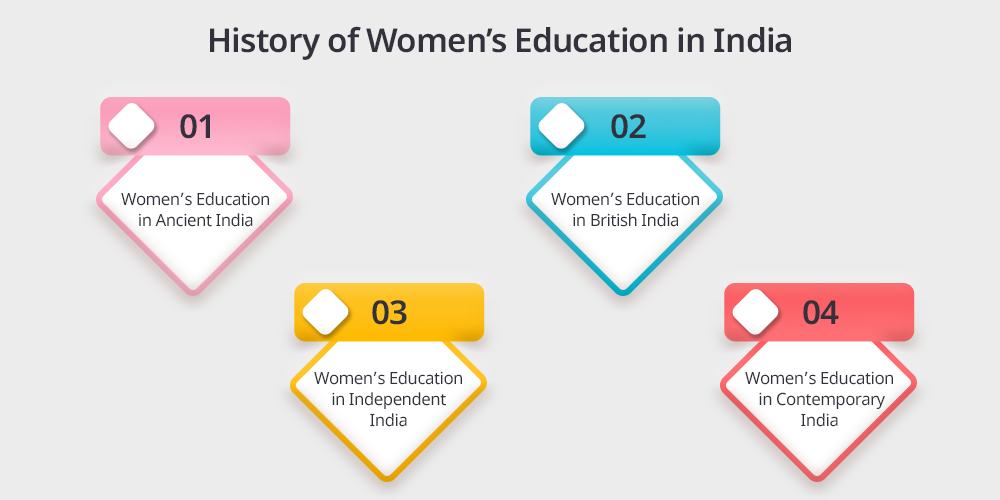
India has a rich tradition of education and culture in the Vedic period women were allowed to pursue education.
During each period women had the liberty of education and other facilities, during that time women’s education was given top priority and various women’s educators and scholarships were also there at that time.
However women’s education was neglected during the Muslim regime, and no efforts were made to promote women’s education in India.
Below you can check the detailed periods of women’s education in India.
1. Women’s Education in Ancient India
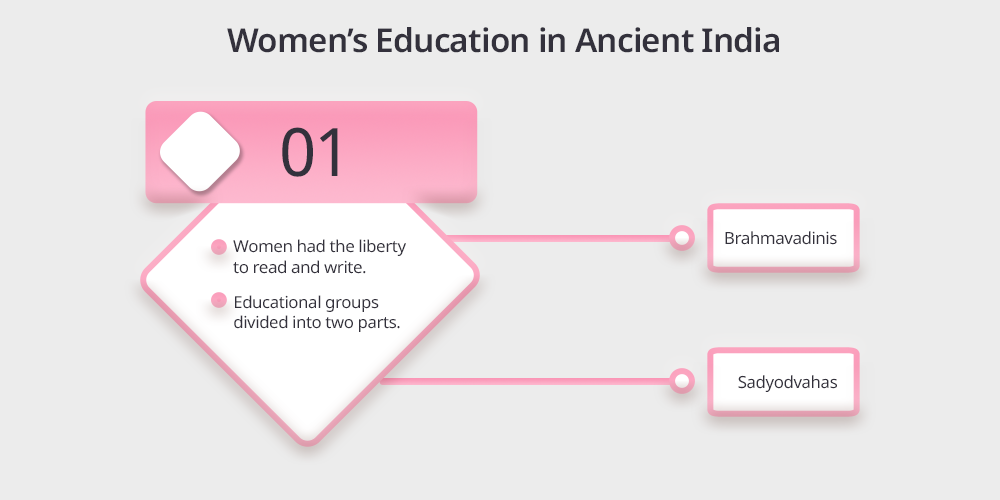
In ancient India, women had the liberty to read and write during that time women’s education was given top priority and various women’s educators and scholars were also there at that time.
Earlier there were two educational groups divided into two parts called Brahmavadinis and Sadyodvahas.
- Brahmavadinis: Brahmavadinis were the students of philosophy and theology, Brahmavadinis was basically a lifelong learning approach at that time.
- Sadyodvahas: Sadyodvahas is followed by students who continue their studies until they get married. In Sadyodvahas basic knowledge of human life, philosophy and ideology were taught.
2. Women’s Education in British India
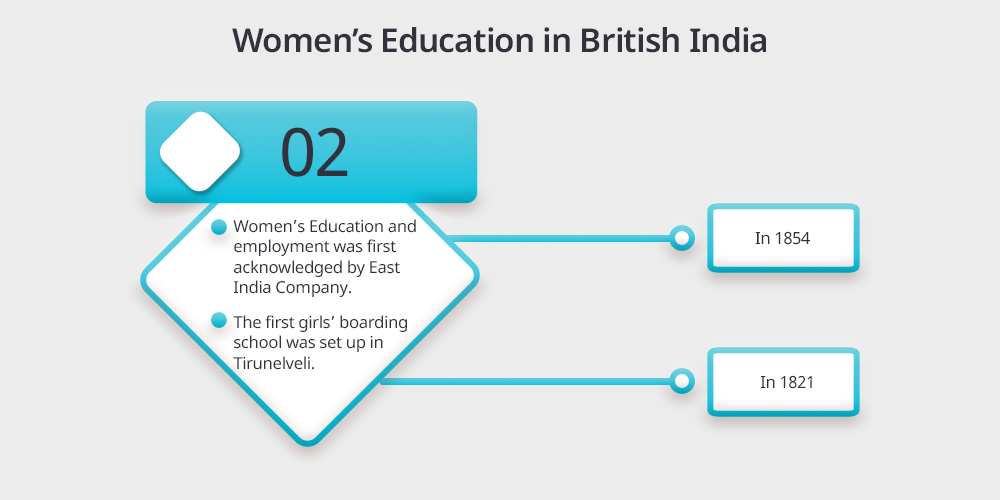
In British India Women’s Education and employment was first acknowledged by East India Company in 1854. During the British regime, the first girls’ boarding school was set up in Tirunelveli in 1821.
Later on, the Scottish Church Society set up a girls school by 1840 with a strength of 200 Hindu girls. In the British era, women’s education was growing slowly, as at that time access of education was only available to upper cast and rich families.
However, by this initiative, the women’s literacy rate has increased from 0.2% in 1882 to 6% in 1947.
3. Women’s Education in Independent India
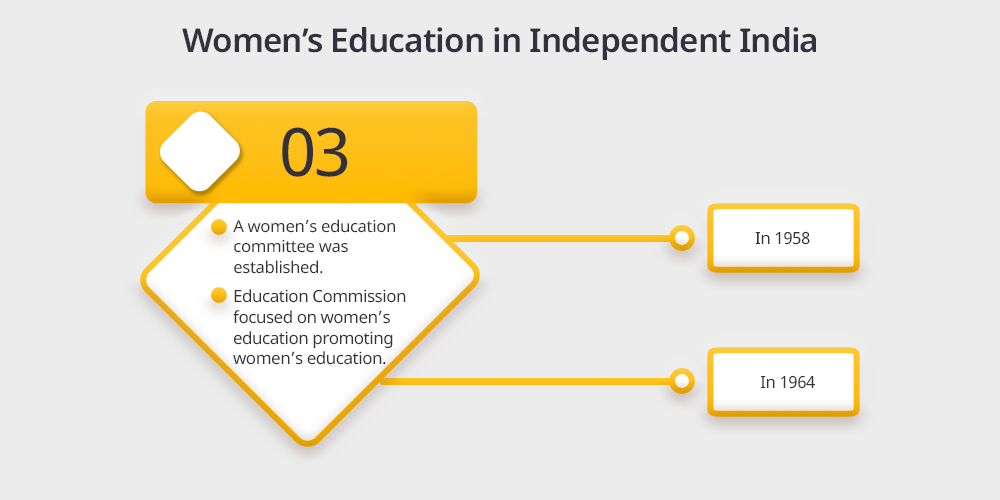
In Independent India, women’s education was not taken into consideration. After the Independence of India, an educational commission was established called the University Grant Commission, however, it didn’t improve women’s literacy rate.
Later on, in 1958 a women’s education committee was established to enhance the women’s literacy rate. Soon after implementing the women’s education policy, various committees were created to provide equality between men and women.
In 1964 education Commission focused on women’s education promoting women’s education and reducing the poverty rate.
4. Women’s Education in Contemporary India
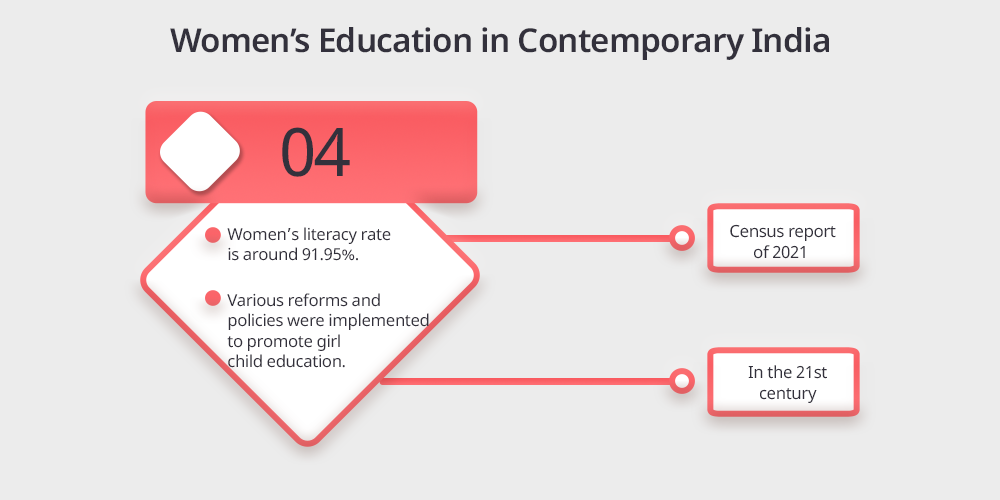
In Contemporary India or modern India women’s education has reached a significant state. By making essential progress and government reforms women’s education has reached a high literacy rate.
According to a census report of 2021, women’s literacy rate is around 91.95% which is probably high as compared to previous years.
Today in the modern world women are a need in every sector whether it is HR, Banking, Agriculture, etc. By educating women they can contribute in economic, social, and financial sectors which will bring developmental growth to the country.
Various reforms and policies were implemented by the government to promote girl child education and even in the 21st century, various initiatives were taken.
However, even with a high literacy rate women find it difficult to pursue their dream education due to cultural barriers, economic barriers, and lack of proper infrastructure creates hindrances among women.
Although, even in the contemporary India Traditional schooling method is still followed which makes it tough for students to meet the changing demand.
Women’s Higher Education History in India
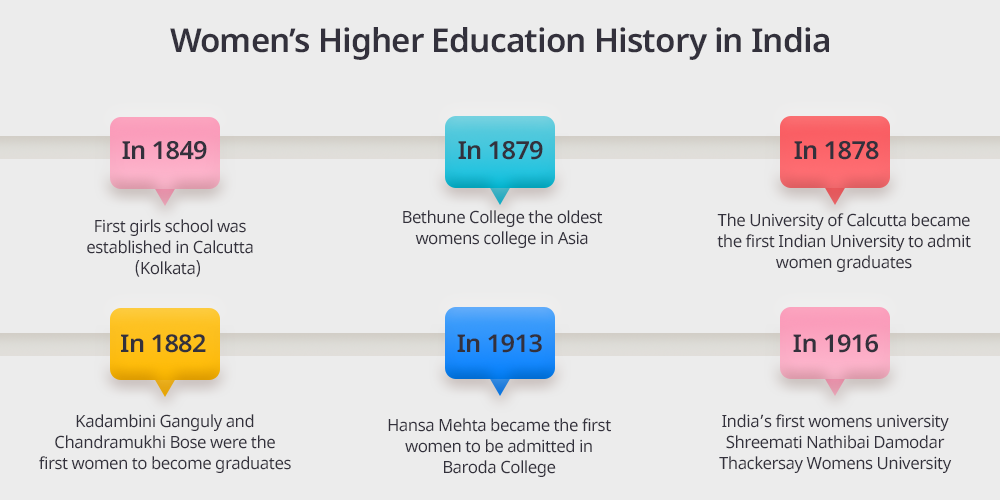
Women’s higher education history has remained complicated for several years. Inequality and gender disparities have remained the main reasons that hindered women’s education in India. In early India, there were no provisions for women’s higher education.
However, in 1849 first girls college was laid out called Bethune School in Kolkata, later on in 1879 it was converted into Bethune College which became India’s oldest women’s college for higher education.
In 1916 India’s first women’s university, Shreemati Nathibai Damodar Thackersey Womens University was founded by social reformer Dr. Dhondo Keshav Karve in Mumbai.
But after implementing the Right to Education Act in 1949 education for women was given importance too. The RTE Act states that everyone has the equal right to complete their education irrespective of any discrepancies.
Even after India’s independence higher education for women’s also not taken into consideration and female literacy rates were very low at that time.
Democratisation of education helps in enhancing women education and promotes women education in society.
Below you can check the detailed periods of women’s education in higher studies.
- In Year 1849: India’s first girls school was established in Calcutta (Kolkata) know as Native Female School, later on, it was renamed as Bethune School.
- In Year 1879: In the year 1879 Bethune School was renamed as Bethune College and became the oldest womens college in Asia.
- In Year 1878: The University of Calcutta became the first Indian University to admit women graduates to its degree programs.
- In Year 1882: Kadambini Ganguly and Chandramukhi Bose were the first women to become graduates in Bachelors of Arts from Calcutta University.
- In Year 1913: Hansa Mehta became the first women to be admitted in Baroda College.
- In Year 1916: India’s first womens university Shreemati Nathibai Damodar Thackersay Womens University was established in Bombay (Mumbai) by Dr. Dhondo Keshav Karghe.
Leaders Who Fought for Women’s Education in India
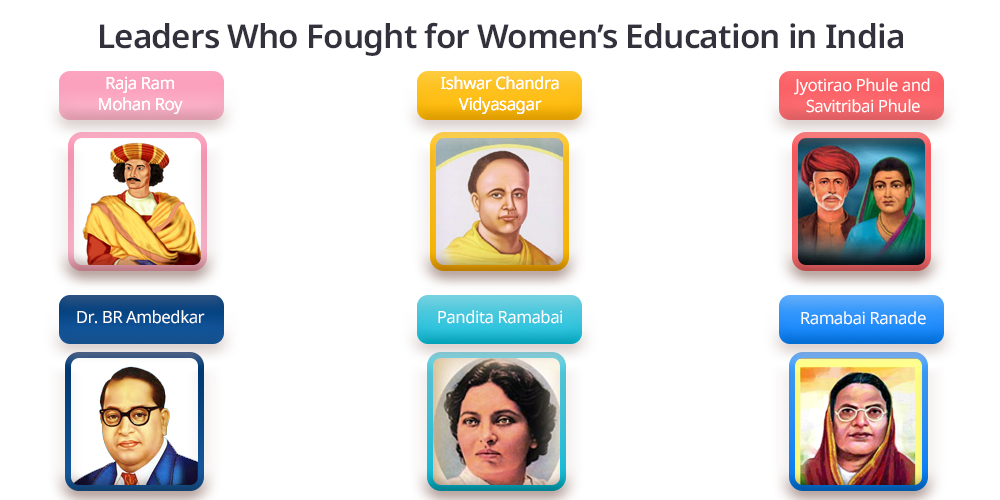
In India, Various women’s educators and reformers have contributed to women’s education which helped in promoting women’s education in India 19th century.
In 1848 Indian pioneers Jyotiba Phule and his wife Savitribai Phule started the first school in India for girl child in 1848 in Pune.
In Eastern India, Various educational reformers were give their contributions to promoting women’s education such as Raja Ram Mohan Roy, Ishwar Chandra Vidyasagar, Ramgopal Ghosh, Raja Dakshinaranjan Mukherjee, Pandit Madan Mohan Tarkalankar, John Elliot, Drinkwater Bethune, etc.
Pandit Madan Mohan Tarkalankar established the first girls school in 1849 which was later known as Bethune School.
The University of Calcutta has become the first to admit women in its graduation program. In 1849 more than 8000 girls from Madras were admitted to missionaries.
Here you can check the reformers who played major role in Women’s Education.
- Raja Ram Mohan Roy: Raja Ram Mohan Roy was a social reformer who is credited for abolishing Sathipratha, child marriage and promote women’s education. He is also known for setting up of Hindu College now Presidency College.
- Ishwar Chandra Vidyasagar: Ishwar Chandra Vidyasagar is a great reformer who fought for girl education. He is also known for his contributions to the Widow Remarriage Act of 1856. Vidyasagar also helped JE Deinkwater to establish a girl school in India called Bethune School.
- Jyotirao Phule and Savitribai Phule: Jyotirao Phule and Savitribai Phule were the prominent reformers in the field of women’s education. In 1848 Phule established the first girls school for all girls irrespective of their backgrounds, and later on between 1848 to 1852 they have opened 18 girls schools.
- Dr. BR Ambedkar: Dr. BR Ambedkar who is known as the Father of the Constitution, fights for women’s rights and education. He states that women’s education must be done in the same school along with mens which ensures that both will get the same education.
- Pandita Ramabai: Pandita Ramabai is a prominent social reformer who fought for girls education. Ramabai was the first women who established schools for Widow women’s. Ramabai has contributed so many efforts to uplift the women’s condition and to promote women’s empowerment.
- Ramabai Ranade: Ramabi Ranade was a social worker who and play major role in advocating women’s education. She established Seva Sadan Institution that focuses on women empowerment and promotes women literacy to rural areas.
Dalit Women’s Education in India
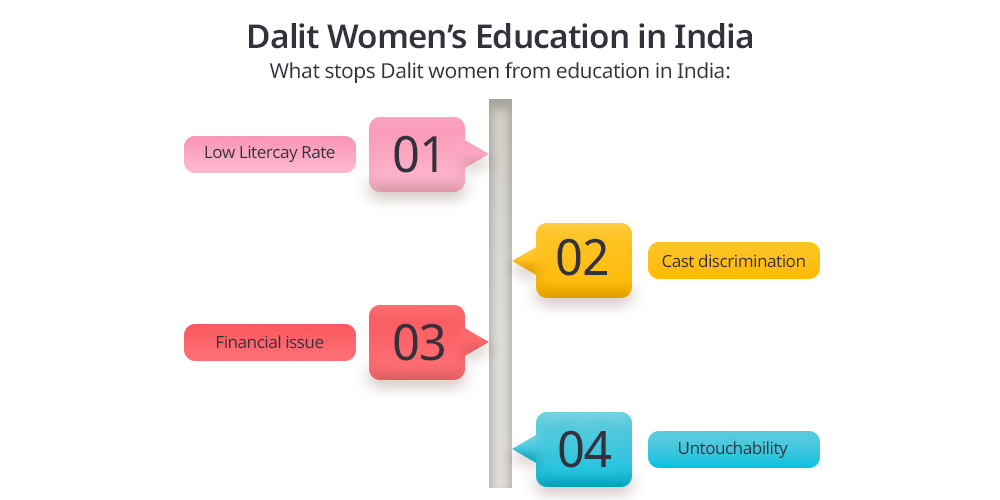
Dalit women in India have educational challenges even in the 21st century. Dalit is a term used for outcasts and untouchability in India.
In India, Dalit women face various challenges due to social, financial, gender, and caste systems. In India, only 23% of Dalit women are educated compared to non-dalit women.
From the beginning of ancient India women from outcasts have faced so many challenges in their life in terms of caste, class and gender which created hindrances for them to pursue education. Even in British India Dalit Women were not allowed to sit in the classrooms and touch any other person.
Discrimination and untouchability in schools have become one of the major reasons for dropouts in schools. Later on, Dr B.R Ambedkar framed the Indian Constitution which states equal education to all irrespective of their status, caste, and gender.
Here you can check what stops Dalit women from education in India:
- Low Litercay Rate: Dalit women’s have been low literacy as compare to non dalit women’s. The cast group has created a huge disparity of access of education for women’s.
- Cast discrimination: Dalit women’s have face backwardness due to cast discrimination. Earlier lower cast women were not allowed to admit in the schools which becomes tough for them to pursue their education.
- Financial issue: Due to financial constraints dalit women’s were unable to complete their education. As earlier women’s who are from good financial backgrounds were allowed to carry on their education.
- Untouchability: It is one of the major issue for dalit womens, Women from lower casts are not allowed to given equal rights. They have faced so many challenges in their life due to various reasons such as caste, class, gender and so on.
Statistics of Women’s Education in India
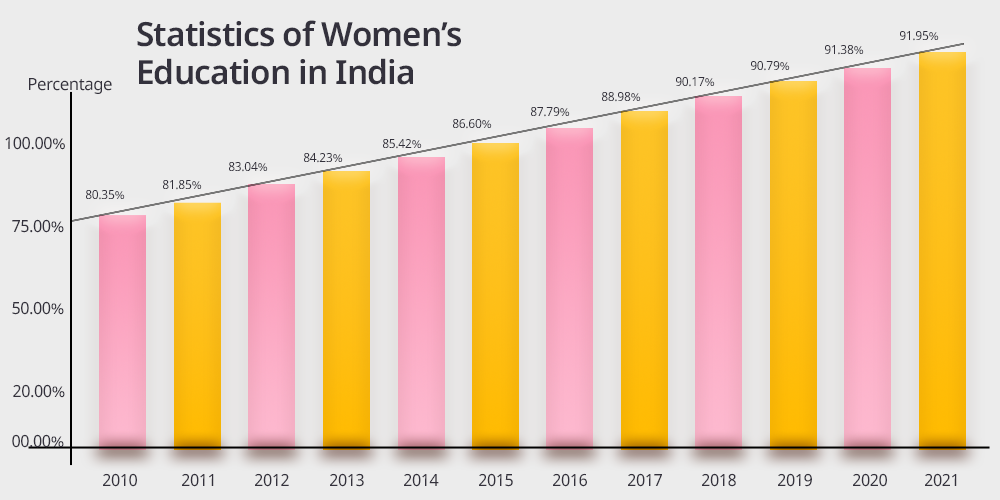
In India women’s education has changed a lot from year to year. Since 2010 every year Indian women’s literacy rate has been growing rapidly.
In 2010 the literacy rate was 80.35% and from 2010 to 2021 it was raised to 14%. In 2021 the literacy rate of women in India has reached 91.95% and every year it is increasing by 0.6%.
Here you can check the graph tabulated below.

State wise Women’s Education in India
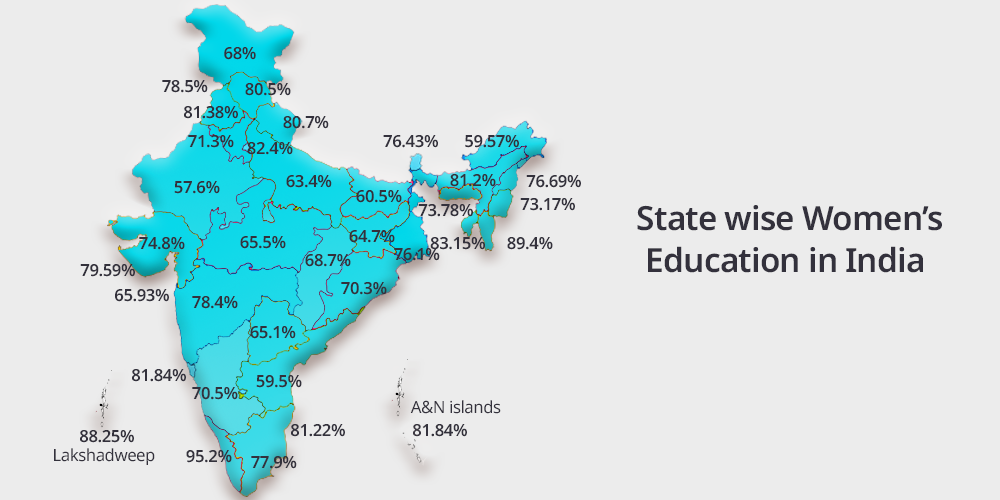
Do you know which state has the highest womens literacy rate in India?
Kerala has the highest womens literacy rate in India with 92.01% and Bihar has the lowest literacy rate with 50%. State wise women’s education in India represents the literacy rate among women.
Below you can check the state wise literacy rate of women in India.
| States & UTs | Female Literacy Rate % |
| A&N islands | 81.84 |
| Andhra Pradesh | 59.5 |
| Arunachal Pradesh | 59.57 |
| Assam | 81.2 |
| Bihar | 60.5 |
| Chandigarh | 81.38 |
| Chhattisgarh | 68.7 |
| Dadra and Nagar Haveli | 65.93 |
| Daman & Diu | 79.59 |
| Delhi | 82.4 |
| Goa | 81.84 |
| Gujarat | 74.8 |
| Haryana | 71.3 |
| Himachal Pradesh | 80.5 |
| Jammu & Kashmir | 68 |
| Jharkhand | 64.7 |
| Karnataka | 70.5 |
| Kerala | 95.2 |
| Lakshadweep | 88.25 |
| Madhya Pradesh | 65.5 |
| Maharashtra | 78.4 |
| Manipur | 73.17 |
| Meghalaya | 73.78 |
| Mizoram | 89.4 |
| Nagaland | 76.69 |
| Odisha | 70.3 |
| Puducherry | 81.22 |
| Punjab | 78.5 |
| Rajasthan | 57.6 |
| Sikkim | 76.43 |
| Tamil Nadu | 77.9 |
| Telangana | 65.1 |
| Tripura | 83.15 |
| Uttar Pradesh | 63.4 |
| Uttarakhand | 80.7 |
| West Bengal | 76.1 |
Current Policies for Women’s Education in India
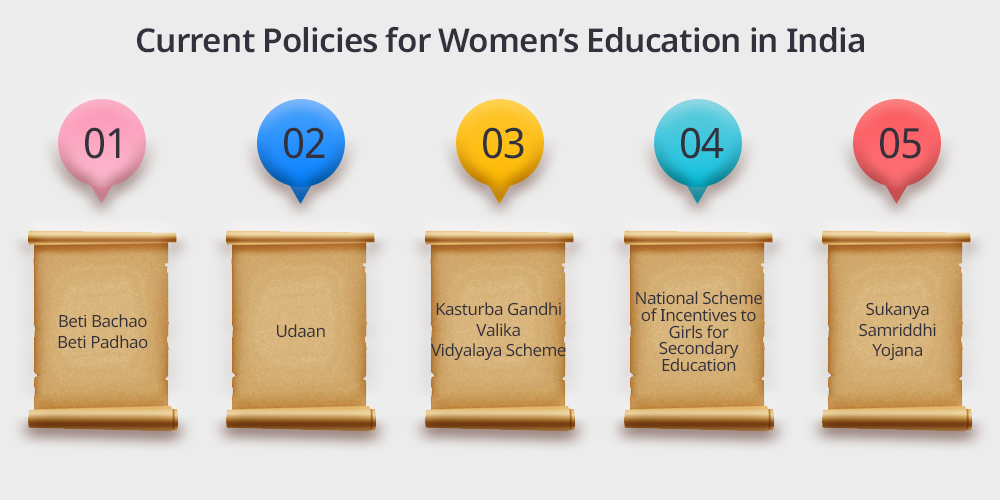
The Indian government has introduced various policies for women to promote women’s education and women’s literacy rate. Improving women’s education is essential and brings a positive impact on health and economic trends.
In India, Various government schemes were introduced for girls to promote women’s education and to change the mindset of people on girl child.
Below are the schemes and policies presented by the government of India:
- Beti Bachao Beti Padhao: Beti Bachao Beti Padhao is one of the successful initiatives implemented in 2015. The main aim of this policy is to promote child sex ratio and girl-child education. The policy focuses on gender equality and increasing the girl child school enrollment.
- Udaan: The Udaan Scheme was introduced in 2013 and became one of the successful initiatives. Udaan scheme focuses on providing developmental schemes to women of economically weaker sections. This policy helps to enhance women’s education in India and provides equal opportunities to them.
- Kasturba Gandhi Valika Vidyalaya Scheme: The Kasturba Gandhi Valika Vidyalaya Scheme was implemented in the year 2004, the main aim of this scheme is to provide education to girls child from weaker sections of the society.
This scheme also focuses on improving the girls enrollment in school to bring equal rights.
- National Scheme of Incentives to Girls for Secondary Education: Under this scheme, an incentive of Rs. 3000 were given to girls who are pursuing secondary education.
The NSIGSE initiative was taken in 2008 and aims to promote secondary education among girls. This scheme has worked very well and female students from different backgrounds have enrolled in secondary education and higher education.
- Sukanya Samriddhi Yojana: The initiative Sukanya Samriddhi Yojana was implemented in 2015 by the government of India.
The main aim of this scheme is to provide financial aid to poor women who are unable to pursue their education due to financial constraints. It’s a small deposit scheme with high interest rates.
Education that empowers womens creativity, skills, thinking ability and promotes women empowerment is essential in developing the society.
Conclusion
In India women education is not only a basic right but also a key factor in the countrys social and economic advancement.
The educational opportunities for women and girls are still hampered by issues like poverty safety concerns gender discrimination and cultural barriers despite tremendous advancements over the years.
Though progress has been made in advancing female education through government programs like Beti Bachao Beti Padhao and Udaan there is still more work to be done to achieve full gender equality in education.
Dispelling myths strengthening communities enhancing health and reducing poverty all depend on educating women.
It is crucial to keep pushing for women’s education as India develops in order to give every girl the chance to learn develop and contribute to society which will create a more just and prosperous country. The availability of the online middle school /british/british-lower-secondary/ can contibute a lot in women’s education.


